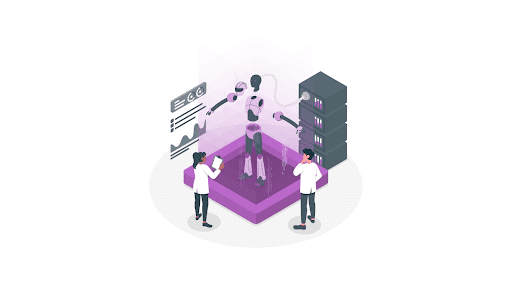Artificial Intelligence (AI) vs Machine Learning vs Deep Learning
Nowadays, individuals reap the benefits of artificial intelligence daily: music recommendation systems, Google maps, Uber, and a host of other apps are all powered by artificial intelligence.
The misunderstanding between the phrases artificial intelligence, machine learning, and deep learning continues to exist. “Are artificial intelligence and machine learning all the same thing?” is one of the most often asked questions in google queries.
Let’s get this out of the way: There are three distinct types for us to understand: artificial intelligence (AI), machine learning (ML) and deep learning (DL).
Artificial intelligence (AI) is a scientific discipline similar to mathematics or biology. It investigates how to develop intelligent algorithms and robots capable of problem-solving on their initiative, something traditionally regarded as a human privilege.
In artificial intelligence (AI), machine learning is a subset of artificial intelligence (AI) that allows systems to automatically learn and improve from their experiences without being explicitly programmed. With machine learning, there are a variety of techniques (for example, neural networks) that may be used to assist in problem-solving.
It is often referred to as Deep Learning or Deep Neural Learning. It is a subset of machine learning that uses neural networks to examine multiple aspects with a structure similar to the human nervous system.
Table of Contents
What is Artificial Intelligence, and how does it work?
Artificial intelligence (AI) imparts facts, knowledge, and human intellect to computers. Artificial intelligence’s primary objective is to produce autonomous machines that can think and behave the same way as humans do. These machines can replicate human behaviour and complete tasks through learning and problem-solving.
The majority of artificial intelligence systems repeat natural intellect to handle challenging issues.
3 Stages of artificial intelligence
1) Narrow AI
Weak or limited artificial intelligence can execute a specific task, but it will not pass for a human in any other sector outside of its established capabilities.
Deep Blue, the first computer to beat a human in chess, is a name you’ve probably heard before. Garry Kasparov, in 1996, was not just an ordinary human being. Deep Blue could generate and analyse over 200 million chess positions every second.
Some people were hesitant to term its artificial intelligence in the traditional sense. Others believed it was one of the early examples of poor artificial intelligence.
Artificial intelligence with a regional focus is now widely applied in scientific, industry, and healthcare settings. A business named DOMO, for example, announced the release of Mr Roboto in 2017.
This artificial intelligence software system incorporates sophisticated analytics capabilities and may give company owners recommendations and insights to help them grow their businesses. It can identify irregularities and recognise patterns, which may be valuable for risk management and resourceful planning, respectively.
Similar programmes exist for various industries, and giant corporations such as Google and Amazon invest resources in their development.
2) General AI
At some time in the future, machines will be able to mimic the behaviour of humans. They are capable of solving logical problems, but they also have feelings. They make their judgments and learn independently, with no assistance from humans.
The question is, how does one go about creating a breathing machine? Chatbots and virtual assistants are already pretty capable of maintaining a conversation. You may configure the computer to respond to certain stimuli by eliciting emotive vocal emotions from the user.
In addition, the trials on teaching machines to sense human emotions are already in progress, with positive results. However, recreating emotional reactions does not always result in the robots being passionate, does it?
3) Active AI
An AI is considered active when it can defeat humans in all tasks or even destroy them. Most people expect to see this type of stuff when reading about artificial intelligence. Machines are light years ahead of humans. Intelligent, knowledgeable, and imaginative. With exceptional social abilities, it seeks to improve the lives of humanity or exterminate them altogether.
The disappointment comes in the form of the fact that today’s scientists would never conceive of building autonomous emotional robots such as the Bicentennial Man. Of course, except for this person, who has developed a robocopy of himself.
Applications of Artificial Intelligence
- Machine Translation applications based on artificial intelligence, such as Google Translate, are becoming increasingly popular.
- Self-driving cars, such as Google’s Waymo, and artificial intelligence robots, such as Sophia and Aibo
- Applications that recognise speech, such as Apple’s Siri or Google’s OK Google, are becoming increasingly popular.
What is Machine Learning, and how does it work?
ML (Machine Learning) is a sort of artificial intelligence. A computer is taught to automate operations that would be too time-consuming or difficult for a human to do. Studying computer algorithms is the most effective tool for analysing, understanding and identifying patterns in data. Machine learning is capable of making judgments with little or no human involvement.
Computers may be taught how to learn without being programmed for a specific purpose by using machine learning, a subset of artificial intelligence (AI). In reality, the core concept of machine learning is that it is feasible to develop algorithms that can learn from and make predictions based on data sets.
A machine-learning-powered system with sufficient data quality and well-chosen characteristics can become superior to humans in a specific task. Any program that uses machine learning is more autonomous than software that uses manually encoded instructions for completing specific tasks. The system learns to spot patterns and generate meaningful predictions as it progresses through the learning process.
Concerning the comparison of Artificial Intelligence vs Machine Learning, machine learning is the process of feeding data into an algorithm that may learn about the relationship between an input and an output. It is possible for a machine to estimate the value or class of a new data point once it has completed its learning process.
Types of Machine Learning
A machine learning algorithm may be divided into three types, which are as follows:
1. Supervised Learning
In supervised learning, the data has already been labelled, indicating that you know the target variable’s existence. Systems may anticipate future events based on historical data when they employ this learning technique. It is necessary to provide the model with at least one input variable and one output variable to be trained.
Linear regression, logistic regression, support vector machines, Naive Bayes, and decision trees are a few examples of supervised learning.
2. Unsupervised Learning
Unsupervised Learning is a method of learning that does not require supervision.
Unsupervised learning algorithms use unlabeled data to uncover patterns in the data on their own, without the assistance of a human. The systems can extract hidden characteristics from the data supplied as input. Once the data has been cleaned up and made more understandable, the patterns and similarities become more apparent.
Unsupervised learning techniques such as k-means clustering, hierarchical clustering, and anomaly detection are examples of what is possible.
3. Reinforcement Learning
The purpose of reinforcement learning is to teach an agent how to execute a task in an unpredictable environment by using positive rewards. The domain provides observations and a bonus to the agent, and the agent responds to the environment by sending actions.
It is the reward that determines how successful the activity was in terms of achieving the task goal.
Reinforcement learning techniques such as Q-learning and Deep Q-learning Neural Networks are examples of this type of algorithm.
Applications of Machine Learning
- Forecasting sales for a variety of different things
- Fraud detection and prevention in banking Product suggestions
- Predictions for the stock market
What is Deep Learning?
Deep learning is the new state of the art in artificial intelligence. Deep learning is computer software designed to emulate the network of neurons seen in the human brain. Deep learning is a subset of machine learning, and it is so named because it uses deep neural networks, which are highly complex.
The machine deploys several different layers to analyse the data it acquires. It is expressed by the number of layers in the model, representing its depth. Deep learning is characterised by using a neural network to facilitate the learning process. Stacking the layers of a neural network on top of each other is an architectural design for neural networks.
In a neural network, information is conveyed from one layer to another through channels that connect the layers. They are referred to as weighted channels since each has a numerical value associated with them.
Every neuron has a unique number that is referred to as bias. This bias is added to the weighted sum of inputs that reach the neuron, and then an activation function is applied to the combined information. The outcome of processed learning is the new state of the art in artificial intelligence decides whether or not the neuron is activated.
Every stimulated neuron sends information to the next tier of the brain’s hierarchy. This continues up to the second-to-last level of the pyramid. And in artificial networks, the output layer will be the final layer of the network. And this layer generates the outputs for the program it is connected to.
Types of Deep Neural Networks
Convolutional Neural Networks (CNN)
In the field of image analysis, CNNs (Convolutional Neural Networks) are a kind of deep neural network that are most widely utilised.
Recurrent Neural Network (RNN)
RNN is a neural network that builds models using sequential input. It is frequently more effective for models that must memorise previous data.
Generative Adversarial Network (GAN)
An algorithmic design that uses two neural networks to generate new, synthetic data instances that appear to be accurate data is known as a Generative Adversarial Network (GAN). A GAN that has been trained on images can create new photographs that appear to human viewers to be at least superficially accurate.
Deep Belief Network (DBN) is a generative graphical model built of numerous layers of latent variables known as hidden units. Each layer is linked to the next, but the units are not connected.
Application of Deep Learning Techniques
- Detection of cancer tumours
- Create your music using the caption bot for picture captioning
- Adding colour to an image
- Detection of objects
What’s Next for Artificial Intelligence?
Researchers are producing advances in artificial intelligence at DeepMind, Google Brain, OpenAI, and numerous institutions at an increasing rate. AI is becoming increasingly capable of tackling increasingly complex issues better than humans.
This means that artificial intelligence is evolving at a rate quicker than its history can be recorded, and forecasts regarding its future are becoming more out of date. Does it seem like we’re on the verge of a breakthrough like nuclear fission (which is feasible), or does it seem like we’re attempting to transform lead into gold with our efforts to squeeze intelligence from silicon?
There are four primary schools of thought that categorise the many ways individuals discuss artificial intelligence.
Those who believe that artificial intelligence advancement will continue at its current rate tend to ponder a lot about strong AI and whether or not it is beneficial to humanity. More intelligent software might save humanity from its everyday stupidity, while superintelligence could pose an existential threat to the whole human species.
Because artificial intelligence increases in tandem with the power of computational hardware, advancements in processing capacity, such as better processors or quantum computing, would pave the way for advances in artificial intelligence.
On a strictly algorithmic level, most of the astounding achievements achieved by laboratories like DeepMind are the result of integrating several techniques into artificial intelligence, much in the same way that AlphaGo mixes deep learning with reinforcement learning. Combining deep knowledge with symbolic thinking, analogical reasoning, Bayesian and evolutionary techniques, among other approaches, appears to be a promising combination.
Concluding Thoughts
Now that you know the difference, types and applications of Artificial Intelligence, Machine Learning and Deep Learning, it is time to apply knowledge. Advancements in mobile app development will be made possible by combining artificial intelligence and machine learning (AI and ML).
If you are still unsure and want to clear up any confusion, please do not hesitate to contact us.
To develop an app that evolves with the passage of time and technological advancement, or to update your existing app with all of the latest technical features, you should partner with a machine learning and artificial intelligence development company that is well-versed in the changing market requirements.
Alternatively, you might want to work with an AI development service provider. However, to ensure excellent outcomes, make sure you select the best.




